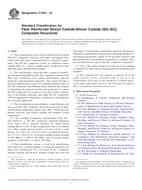Potřebujeme váš souhlas k využití jednotlivých dat, aby se vám mimo jiné mohly ukazovat informace týkající se vašich zájmů. Souhlas udělíte kliknutím na tlačítko „OK“.
ASTM C1835-16
Standard Classification for Fiber Reinforced Silicon Carbide-Silicon Carbide (SiC-SiC) Composite Structures
Automaticky přeložený název:
Standardní klasifikace pro vyztužené vlákny karbidu křemíku, karbidu křemíku (SiC-SiC) kompozitních konstrukcí
NORMA vydána dne 1.2.2016
Informace o normě:
Označení normy: ASTM C1835-16
Poznámka: NEPLATNÁ
Datum vydání normy: 1.2.2016
Kód zboží: NS-633388
Počet stran: 6
Přibližná hmotnost: 18 g (0.04 liber)
Země: Americká technická norma
Kategorie: Technické normy ASTM
Kategorie - podobné normy:
Anotace textu normy ASTM C1835-16 :
Keywords:
classification, mechanical properties, physical properties, silicon carbide composites, silicon carbide fiber,, ICS Number Code 81.060.10 (Raw materials)
Doplňující informace
| Significance and Use | ||||||||||||||||||||||||||||||
|
4.1 Composite materials consist by definition of a reinforcement phase/s in a matrix phase/s. The composition and structure of these constituents in the composites are commonly tailored for a specific application with detailed performance requirements. For fiber reinforced ceramic composites the tailoring involves the selection of the reinforcement fibers (composition, properties, morphology, interface coatings, etc.), the matrix (composition, properties, and morphology), the composite structure (component fractions, reinforcement architecture, interface coatings, porosity structure, microstructure, etc.), and the fabrication conditions (assembly, forming, densification, finishing, etc.). The final engineering properties (physical, mechanical, thermal, electrical, etc) can be tailored across a broad range with major directional anisotropy in the properties. 4.2 This classification system assists the ceramic composite designer/user/producer in identifying and organizing different types of silicon carbide-silicon carbide (SiC-SiC) composites (based on fibers, matrix, architecture, physical properties, and mechanical properties) for structural applications. It is meant to assist the ceramic composite community in developing, selecting, and using SiC-SiC composites with the appropriate composition, construction, and properties for a specific application. 4.3 This classification system is a top level identification tool which uses a limited number of composites properties for high level classification. It is not meant to be a complete, detailed material specification, because it does not cover the full range of composition, architecture, physical, mechanical, fabrication, and durability requirements commonly defined in a full design specification. Guide C1793 provides direction and guidance in preparing a complete material specification for a given SiC-SiC composite component. |
||||||||||||||||||||||||||||||
| 1. Scope | ||||||||||||||||||||||||||||||
|
1.1 This classification covers silicon carbide-silicon carbide (SiC-SiC) composite structures (flat plates, rectangular bars, round rods, and tubes) manufactured for structural components. The SiC-SiC composites consist of continuous silicon carbide fibers in a silicon carbide matrix produced by four different matrix densification methods. 1.2 The classification system provides a means of identifying and organizing different SiC-SiC composites, based on the fiber type, architecture class, matrix densification, physical properties, and mechanical properties. The system provides a top-level identification system for grouping different types of SiC-SiC composites into different classes and provides a means of identifying the general structure and properties of a given SiC-SiC composite. It is meant to assist the ceramics community in developing, selecting, and using SiC-SiC composites with the appropriate composition, construction, and properties for a specific application. 1.3 The classification system produces a classification code for a given SiC-SiC composite, which shows the type of fiber, reinforcement architecture, matrix type, fiber volume fraction, density, porosity, and tensile strength and modulus (room temperature). 1.3.1 For example, Composites Classification Code, SC2-A2C-4D10-33—a SiC-SiC composite material/component (SC2) with a 95 %+ polymer precursor (1.4 This classification system is a top level identification tool which uses a limited number of composite properties for high level classification. It is not meant to be a complete, detailed material specification, because it does not cover the full range of composition, architecture, physical, mechanical, fabrication, and durability requirements commonly defined in a full design specification. Guide C1793 provides extensive and detailed direction and guidance in preparing a complete material specification for a given SiC-SiC composite component. 1.5 Units—The values stated in SI units are to be regarded as standard. No other units of measurement are included in this standard. 1.6 This standard does not purport to address all of the safety concerns, if any, associated with its use. It is the responsibility of the user of this standard to establish appropriate safety and health practices and determine the applicability of regulatory limitations prior to use. |
||||||||||||||||||||||||||||||
| 2. Referenced Documents | ||||||||||||||||||||||||||||||
|
Odebírejte informace o nově vydaných normách ZDARMA:
Chcete pravidelně odebírat informace o nově vycházejících normách z celého světa a to zcela zdarma?
Přihlašte se k odběru. Vše je velice jednoduché a absolutně ZDARMA.
Na výběr máte vydavatele z celého světa.




 Cookies
Cookies
